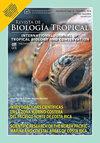辅助珊瑚修复对东太平洋珊瑚礁碳酸钙生产的贡献
IF 0.6
4区 生物学
Q4 BIOLOGY
引用次数: 0
摘要
简介:非典型珊瑚有能力构建物理珊瑚礁框架,并保持珊瑚礁功能的平衡。然而,在过去的三十年里,珊瑚群落一直受到自然和人类压力的威胁,导致珊瑚覆盖率突然下降,自然恢复缓慢。为了缓解珊瑚礁坍塌,世界各地都实施并改进了辅助修复技术。然而,这种干预措施对生态特性的长期影响几乎没有报道。目的:本研究评估了辅助珊瑚干预对墨西哥太平洋中部分支珊瑚和块状珊瑚产生的碳酸钙产量(kg CaCO3 m-2 yr-1)和生态体积(cm3)的影响。方法:我们使用直接种植的Pocillopora和Pavona珊瑚物种的菌落大小、扩展率和骨骼密度测量来计算珊瑚碳酸盐的产量、生态量,并对其长期潜力进行建模。结果:外植一年后产生的珊瑚碳酸盐增加了42%(1.17 kg CaCO3 m-2 yr-1),其中Pocillopora spp.和Pavona棒珊瑚分别贡献了0.97和0.20 kg CaCO3 m-1 yr-1。一年后,Pocillopora和Pavona的生态体积分别增加了384 cm3和56 cm3。此外,研究结果表明,长期珊瑚恢复行动(10年)有可能显著增加碳酸盐产量。结论:我们的数据表明,珊瑚恢复举措有可能帮助缓解墨西哥太平洋珊瑚礁目前的低碳酸钙产量,并可能对基于生态工程工具的珊瑚礁框架的长期维护做出重大贡献,这些举措代表了与珊瑚礁生态系统服务提供相关的重要功能特性。本文章由计算机程序翻译,如有差异,请以英文原文为准。
The contribution of assisted coral restoration to calcium carbonate production in Eastern Pacific reefs
Introduction: Hermatypic corals have the capacity to construct the physical reef-framework and maintain the balance of coral reef functionality. However, in the past three decades, coral communities have been menaced by natural and anthropic pressures, resulting in an abrupt coral cover decline, and slow natural recovery. To mitigate coral reef collapse, assisted restoration techniques has been implemented and improved worldwide, However, the long-term effects of such interventions on ecological attributes have been scarcely reported.
Objective: This study evaluated the effect of assisted coral intervention on calcium carbonate production (kg CaCO3 m-2 yr-1) and ecological volume (cm3) yielded by branching and massive corals from the central Mexican Pacific.
Methods: We used colony size, extension rate, and skeletal density measurements of direct outplanted Pocillopora and Pavona coral species to calculate coral carbonate production, ecological volume, and model their long-term potential.
Results: Coral carbonate produced after one-year of outplanting increased by 42 % (1.17 kg CaCO3 m-2 yr-1), where Pocillopora spp. and Pavona clavus corals contribute with 0.97 and 0.20 kg CaCO3 m-2 yr-1, respectively. The ecological volume also increased by 384 cm3 for Pocillopora and 56 cm3 for Pavona after one year period. Furthermore, the results suggest that long-term coral restoration actions (10 years) have the potential to significantly increase carbonate production.
Conclusions: our data indicate that coral restoration initiatives have the potential to help mitigate the current low calcium carbonate production of Mexican Pacific reefs and may significantly contribute to the long-term maintenance of reef-framework based on ecological engineering tools, such initiatives represent essential functional properties related to reef ecosystem services provision.
求助全文
通过发布文献求助,成功后即可免费获取论文全文。
去求助
来源期刊

Revista De Biologia Tropical
生物-生物学
CiteScore
1.80
自引率
0.00%
发文量
23
审稿时长
4-8 weeks
期刊介绍:
The Revista de Biología Tropical / International Journal of Tropical Biology and Conservation is a mainstream scientific journal published since 1953 and covered by Web of Science; Science Citation Index; Current Contents; Google Scholar; Scopus, SciELO and nearly 50 additional indices.
A double blind system guarantees you a fair evaluation, and our world class editorial and scientific boards provides a first decision in three working days. The journal is Full Open Access and is widely read where your article can have the highest real impact.
Since its beginning in 1953, the Revista follows these principles: objective and independent evaluation of all manuscripts; transparency in all processes; ethical use of procedures, data, specimens and subjects; fair treatment of all parties; and absolute predominance of scientific rigor over any other aspect.
 求助内容:
求助内容: 应助结果提醒方式:
应助结果提醒方式:


